 To enhance service speed and avoid tariff delays, we've opened a US warehouse. All US orders ship directly from our US facility.
To enhance service speed and avoid tariff delays, we've opened a US warehouse. All US orders ship directly from our US facility.
| Cat. No. | Product Name | Field of Application | Chemical Structure |
|---|---|---|---|
| DC7920 | Liproxstatin-1 Featured |
Liproxstatin-1 is able to suppress ferroptosis in cells, in Gpx4(-/-) mice, and in a pre-clinical model of ischaemia/reperfusion-induced hepatic damage.
More description
|

|
| DC6905 | Linezolid (PNU-100766) Featured |
Linezolid (Zyvox) is a synthetic antibiotic used for the treatment of serious infections.
More description
|
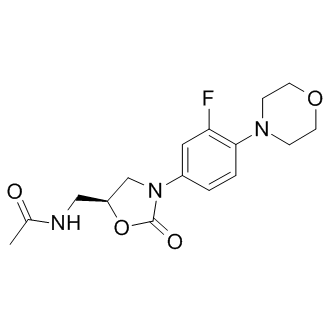
|
| DC7454 | LH846 Featured |
LH846 is a selective inhibitor of CK1δ (IC50 values are 290 nM, 1.3 uM and 2.5 uM for CK1δ, ε and α); displays no inhibitory activity at CK2.
More description
|

|
| DC7018 | LGX-818(Encorafenib) Featured |
LGX818 is an orally available mutated BRaf V600E inhibitor(IC50=0.3 nM) with potential antineoplastic activity.
More description
|

|
| DC7186 | LGK-974 Featured |
LGK-974 is a potent and specific PORCN inhibitor, and inhibits Wnt signaling with IC50 of 0.4 nM.
More description
|

|
| DC8714 | Levobetaxolol hydrochloride Featured |
Levobetaxolol hydrochloride is a beta-adrenergic receptor inhibitor (beta blocker), used to lower the pressure in the eye in treating conditions such as glaucoma.
More description
|

|
| DC7631 | Lesinurad (RDEA594) Featured |
Lesinurad(RDEA594), once-daily inhibitor of URAT1, is a transporter in the kidney that regulates uric acid excretion from the body.
More description
|

|
| DC9186 | Lercanidipine HCl |
Lercanidipine hydrochloride is a calcium channel blocker of the dihydropyridine class.
More description
|
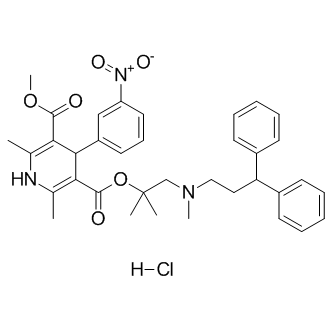
|
| DC7453 | Ribociclib (LEE011) Featured |
LEE011 is an orally available cyclin-dependent kinase (CDK) inhibitor targeting cyclin D1/CDK4 and cyclin D3/CDK6 cell cycle pathway, with potential antineoplastic activity.
More description
|

|
| DC7947 | Ledipasvir Featured |
Ledipasvir(GS5885) is an inhibitor of the hepatitis C virus NS5A protein. Ledipasvir is an experimental drug for the treatment of hepatitis C.
More description
|

|
| DC7610 | LDN-57444 Featured |
LDN-57444 is a reversible, competitive proteasome inhibitor for Uch-L1 with IC50 of 0.88 μM, 28-fold selectivity over isoform Uch-L3.
More description
|
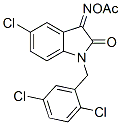
|
| DC7914 | LDN-214117 Featured |
LDN-214117 is a potent and selective ALK2 inhibitor with IC50 of 22 nM; > 100 fold selectivity for ALK5; also inhibits BMP6(IC50=100 nM).
More description
|

|
| DC7586 | LDN-212854 Featured |
LDN-212854 is a potent and selective BMP receptor inhibitor with IC50 of 1.3 nM for ALK2, about 2-, 66-, 1641-, and 7135-fold selectivity over ALK1, ALK3, ALK4, and ALK5, respectively.
More description
|

|
| DC9432 | LDN-212320 Featured |
LDN-212320(OSU-0212320) is a glutamate transporter EAAT2 activator; enhances EAAT2 levels by > 6 fold at concentrations < 5 μM after 24 h.
More description
|

|
| DC8231 | LDN-192960 2HCl Featured |
LDN-192960 is a potent and selective inhibitor of haspin (Haploid Germ Cell-Specific Nuclear Protein Kinase). IC50 = 0.010 µm
More description
|
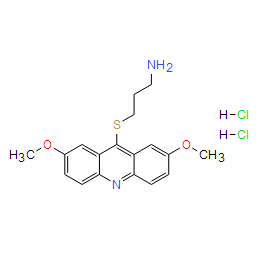
|
| DC5167 | Ceritinib(LDK378) Featured |
LDK378 is a highly selective ALK inhibitor with IC50 of 2 nM
More description
|

|
| DC7185 | LDE225 Diphosphate Featured |
LDE225 (NVP-LDE225) is a Smoothened (Smo) antagonist, inhibiting Hedgehog (Hh) signaling with IC50 of 1.3 nM (mouse) and 2.5 nM (human), respectively. Phase 3.
More description
|

|
| DC9394 | LDC000067 Featured |
LDC000067(LDC-067) is a highly specific CDK9 inhibitor with IC50 of 32.7 nM for CDK9/cyclin T1; displays 55/125/210/ >227/ >227-fold selectivity for CDK9 versus CDK2/1/4/6/7.
More description
|

|
| DC7707 | LCZ-696 Featured |
LCZ696 is a first-in-class dual inhibitor of the angiotensin II receptor(AT II receptor) and neprilysin; a novel single molecule comprising molecular moieties of valsartan and NEP inhibitor prodrug AHU377 (1:1 ratio).
More description
|

|
| DC7801 | LB-100 Featured |
LB-100 is a small-molecular protein phosphatase 2A(PP2A)inhibitor with IC50 of 0.85 μM and 3.87 μM in BxPc-3 and Panc-1 cells.
More description
|

|
| DC11900 | Lazertinib Featured |
Lazertinib (YH25448, GNS-1480) is a highly potent, mutant-selective, irreversible, brain-penetrant and orally active EGFR tyrosine-kinase inhibitors for both the T790M mutation and activating EGFR mutations
More description
|

|
| DCAPI1501 | Lasofoxifene tartrate Featured |
Lasofoxifene Tartrate is a non-steroidal selective estrogen receptor modulator (SERM).
More description
|

|
| DC7710 | Lasmiditan (COL-144; LY573144) Featured |
Lasmiditan (COL-144; LY573144) is a high-affinity, highly selective 5-HT1F receptor agonist(Ki=2.1 nM), compared with Ki of 1043 nM and 1357 nM at the 5-HT(1B) and 5-HT(1D) receptors, respectively.
More description
|
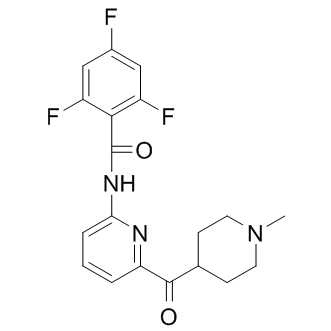
|
| DC3143 | Lapatinib ditosylate Featured |
Lapatinib Ditosylate (GW572016, GW2016, Tykerb, Tyverb) is a potent EGFR and ErbB2 inhibitor with IC50 of 10.8 and 9.2 nM, respectively.
More description
|

|
| DCAPI1512 | Lapatinib Featured |
Lapatinib
More description
|

|
| DC23858 | Lanraplenib (GS-9876) Featured |
Lanraplenib is a potent, selective Syk kinase inhibitor for treatment various disease states, including cancer and inflammatory conditions.
More description
|

|
| DC8092 | L-755,507 Featured |
L-755,507 enhances CRISPR-mediated homology-directed repair (HDR) efficiency in human induced pluripotent stem cells (iPSCs).
More description
|

|
| DC8578 | L002(NSC764414) Featured |
L002 is a p300 inhibitor (IC50=1.98 μM) that inhibits p53 and histone acetylation. Suppresses STAT3 activation in vitro and suppresses tumor growth in some mouse cell lines.
More description
|

|
| DC7934 | L-006,235 Featured |
L 006235 is a reversible and potent cathepsin K inhibitor that displays more than a 4000 fold selectivity over cathepsins B, L and S.
More description
|

|
| DC1032 | KY02111 Featured |
KY02111 promotes differentiation of hPSCs to cardiomyocytes by inhibiting WNT signaling.
More description
|

|